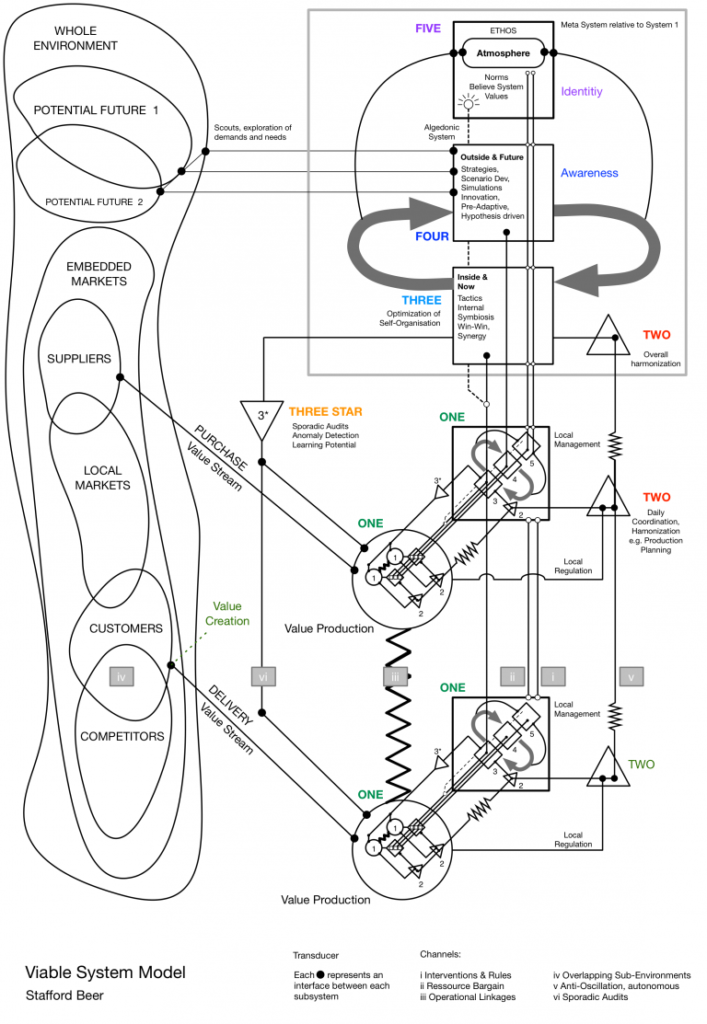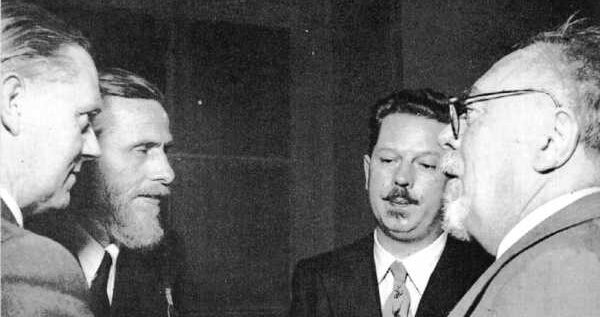Cybernetics was launched in 1948 by Norbert Wiener from MIT who defined it as the science of control and communication in the animal and machine.
He chose the word Cybernetics – which comes from the Greek ‘Kubernetes’ meaning “steersmanship” to encapsulate the many and various elements a system must exhibit in order to steer a course towards a goal. In the early, post WWII, era many of the early cyberneticians like Ross Ashby and Stafford Beer referred to cybernetics as steersmanship, and this view is still prevalent today.
Others had a different view. Gregory Bateson referred to cybernetics as the “biggest bite out of the fruit of the Tree of Knowledge in 2000 years”. He believed that it gave us a new and more valid way of looking at the world based on circuits and loops and patterns. Many agree: McCulloch described cybernetics as experimental epistemology, and more recently Humberto Maturana described it as “the science and art of understanding”
However, you look at it, cybernetics is a multidisciplinary scientific field for understanding complex systems, ranging from biological organisms to artificial intelligence and organisational structures. It is essentially a meta-science, looking for principles which can be identified in all disciplines, or as Bateson said – the pattern that connects. This extends from looking at the way that humans function in order to build robots to studying the brain in order to design effective social organisations.
With other pioneering cyberneticians coming from such fields as neurophysiology, psychiatry, mathematics, biology, and anthropology they agreed on generic cybernetic laws resulting from observing basic mechanisms for learning and cognition in humans and their social systems. Heinz Von Foerster, Warren Mc Culloch, Gregory Bateson, Margaret Mead, Ross Ashby, Gordon Pask, Stafford Beer, Humberto Maturana and Francisco Varela were early pioneers in cybernetics.
Many of us believe, like Bateson, that this new way of looking at the world is of the utmost importance. As the American Society of Cybernetics says:
“Looking at the world today, it would be difficult not to conclude that a way of thinking which, rather than foster competition and conflict, deliberately aims at adaptation and collaboration may be the only way to maintain human life on this planet.”
The meaning of Cybernetics
Cybernetics emerged from studying scientifically the basic laws ruling self-regulation, self-organisation, autonomy, communication, adaptation, and complexity, which are applicable to many different scientific fields. It is a meta-disciplinary science. Cybernetic theory and principles set up the basis for the development of computers, the internet, and artificial intelligence; and influenced the development of social and living sciences, like psychotherapy, management sciences and biology.
Warren Mc Culloch explained cybernetics as experimental epistemology concerned within an observer generating knowledge by interacting with other observers and its surrounding environment. Stafford Beer, mentored by Mc Culloch and Ashby, developed Management Cybernetics (nowadays referred as Organisational Cybernetics) as the science that studies effective organisation in social systems.
Many have judged cybernetics as being a mathematical science based in objectivism and supporting a mechanistic understanding of human beings and organisations. However, social cybernetics – including Organisational Cybernetics, the Santiago School of Cognition and others, consider knowledge not to be a picture of an ‘objective reality’ but quite differently, to be a particular way of organising experience and highly subjective. Social cybernetics has provided a robust theoretical basis for understanding dynamic equilibrium (homeostasis) between individuals, groups of individuals, their societies, and ecosystems.
Organizational Cybernetics
Organisational Cybernetics (OC) applies the principles of cybernetics to the diagnosis and design of social living organisations. It views organizations as complex, adaptive systems that require effective self-regulation and adaptation capabilities to survive and thrive. Based in the field of human cognition, organisational cybernetics seeks to understand how organizations (e.g., business, communities, networks, public enterprises) can be designed to be viable, which means capable of maintaining an independent existence in a turbulent environment.
A viable system is capable of continuous self-organisation, through effective learning and adaptation to keep itself in a ‘dynamic equilibrium’ in its interaction with its environment. The Viable System Model, developed by Stafford Beer, provides the basic criteria of effective organisation which can be used to (re)design organisations as viable systems.

Stafford most famous project was the Cybersyn project in Chile, in 1971-1973 supporting Salvador Allende’s government to develop a cybernetic experiment to steer the then socialist nation. The project has inspired global interest and continues to do so – see for example the recent 50-year anniversary of the project.
Team Syntegrity was the last of Stafford’s invention, as is a methodology to facilitate complex group decisions in a highly interactive and democratic protocol, inspired by Buckminster Fuller’s ideas of the icosahedron.
The Current Situation
Today, cybernetics, and particularly Organisational Cybernetics and the VSM, is more important than ever for fields such as management science, operational research, and information systems. The digital, globalised age, with its complex networks and rapid information flow, has brought new relevance to cybernetic principles. Organisations apply these concepts to improve resilience, adaptability, and efficiency in an increasingly unpredictable world.
The Viable System Model remains a powerful tool for diagnosing organisational problems and designing adaptive, sustainable structures. In an era of global interconnectedness, the cybernetic emphasis on dynamic equilibrium, real time information, agile decision making, and system viability offers valuable insights for managing organisational complexity and change.
Team Syntegrity has been extensively used since Stafford invented it in the early nineties. Experience using it has proven its relevance as a highly effective and creative way of generating agreements (or clarifying disagreements) in large groups of people.
More recent theories and methodologies – also inspired by basic cybernetic principles – have demonstrated their effectiveness like holocracy, sociocracy, and teal organisations. Nevertheless, Beer’s original theory, the VSM, remains the only one which offers a holistic complete model of an organisation, which explains the way it deals with internal and external complexity, clarifies all the principles and criteria for managing complexity, and offers a robust meta-language to design agile and self-governed organisations. Newer theories and methodologies complement aspects of the praxis which have proven to very important and useful in practice.
Not surprisingly, the interest in organisational cybernetics continue growing and that is precisely one of the aims of the Metaphorum Community, to create an effective context for the development of OC.
A short introduction into the Viable System Model and a few Videos with Stafford Beer to get started.
An event format called a Syntegration, normally oriented for collective and participatory decision making on crucial issues for organisational identity, development or policy implementation.
The Cybersyn project, started 1971 under Salvador Allende, aimed to steer the economy of Chile using cybernetic principles. The project aimed to acquire the benefits of cybernetic synergy for the whole industry, while developing power for the workers at the same time.

